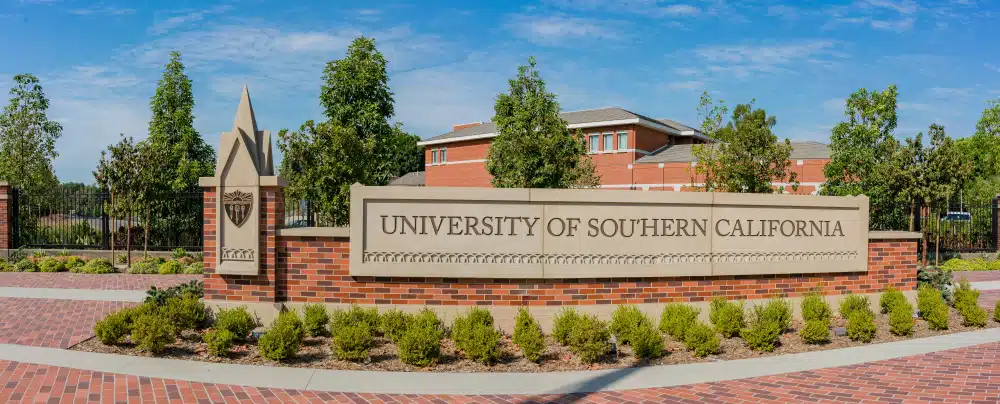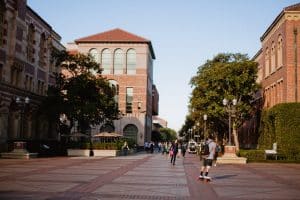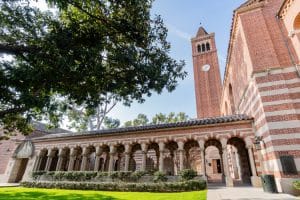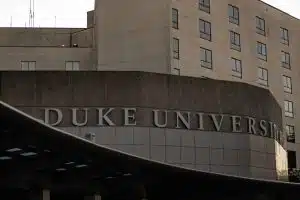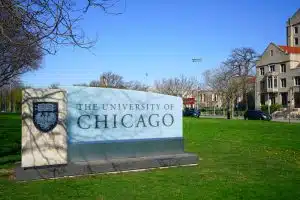Where Is the USC Located?
The University of Southern California, also known as USC, is a renowned private research university with a rich history, influential presence, and a location that is central to the vibrant metropolis of Los Angeles, California. Where the university is located has played a significant role in its development and identity, and what makes USC unique.
Understanding the University of Southern California
A Brief History of USC
Founded in 1880, the University of Southern California is the oldest private research university in California. USC was established when Los Angeles was a burgeoning frontier town in the early stages of its growth, far from the established centers of learning in the East. The founders envisioned a cultural institution that would contribute towards the development of the city and its residents, an ideal that is upheld to this day.
Since its humble beginnings, USC has experienced remarkable growth and transformation. From a small institution with a handful of students, it has evolved into a prestigious university with a diverse student body and a renowned faculty. Over the years, USC has become a pioneering research institution known for its innovation and contribution across multiple disciplines. Its commitment to academic excellence and its dedication to making a positive impact on society have solidified its position as a leading educational institution.
One of the key factors that have contributed to USC’s success is its location. Situated in the heart of Los Angeles, the university benefits from the vibrant and dynamic environment that the city offers. Los Angeles, known as the entertainment capital of the world, is a hub of creativity and innovation. The city’s rich cultural heritage, coupled with its thriving arts scene, provides an inspiring backdrop for students pursuing degrees in various artistic disciplines.
Moreover, Los Angeles is not only renowned for its entertainment industry but also for its booming business sector. The city is home to numerous multinational corporations, startups, and entrepreneurial ventures. USC students have the unique advantage of being in close proximity to these industries, opening up a world of opportunities for internships, partnerships, and employment. The university’s strong ties with the business community further enhance these opportunities, ensuring that students gain valuable real-world experience and develop the skills necessary to thrive in their chosen fields.
The Importance of USC’s Location
USC is located in Los Angeles and provides an environment that not only enriches students’ educational experiences but also presents a plethora of opportunities in numerous fields such as arts, businesses, and technological innovations. Being located at the heart of one of the most culturally diverse and economically dynamic cities in the world has significantly contributed to USC’s vibrant and diverse nature.
Furthermore, the city’s proximity to industries such as Hollywood, Silicon Beach, and numerous headquarters of multinational corporations provides an unparalleled advantage to the students and faculty at USC for partnerships, internships, and employment opportunities. USC’s strong connections with these industries ensure that students have access to cutting-edge research, state-of-the-art facilities, and industry-leading professionals.
Los Angeles is not only a city of opportunities but also a city of dreams. It attracts individuals from all walks of life who come to pursue their passions and ambitions. USC, being an integral part of this dynamic city, fosters a sense of community and collaboration among its students. The university encourages students to explore their interests, engage in community service, and make a positive impact on society.
USC’s commitment to diversity and inclusion is reflected in its student body, which comprises individuals from different backgrounds, cultures, and perspectives. This diversity enriches the learning environment and prepares students to thrive in a globalized world.
The university’s dedication to fostering a sense of belonging and promoting social justice ensures that every student feels valued and supported throughout their academic journey.
In conclusion, the University of Southern California is not just a place of learning; it is a vibrant and dynamic institution that embraces the spirit of Los Angeles. From its humble beginnings to its current status as a leading research university, USC has remained true to its founding ideals of contributing to the development of the city and its residents.
With its prime location, diverse student body, and strong industry connections, USC continues to provide an exceptional educational experience that prepares students for success in an ever-changing world.
The Geographic Location of USC
USC’s Position in Los Angeles
The University of Southern California (USC) is located in the University Park neighborhood of Los Angeles. This part of the city, located just south of downtown, got its name from USC’s presence.
The University Park neighborhood is a vibrant and diverse community that offers a unique blend of culture, history, and academic excellence. Located in close proximity to downtown Los Angeles, students at USC have access to a wide range of opportunities for internships, networking, and cultural experiences.
Surrounded by iconic landmarks such as the Los Angeles Memorial Coliseum and Exposition Park, USC’s campus is not only a hub of education but also a center for sports, entertainment, and recreation. Students can enjoy attending USC Trojans football games or explore the various museums and gardens in the area.
While USC’s position in Los Angeles offers many benefits, it also presents numerous challenges that the university continually strives to address. Balancing the role of an urban research university with the needs and expectations of its surrounding community is a complex endeavor, but USC’s commitment to this task is paramount to its mission.
Accessibility and Transportation to USC
The USC campus is highly accessible, with multiple freeways located nearby including the 10 and 110 freeways, and the presence of a Metro Rail station on campus which connects USC to regions beyond downtown. This convenient transportation network allows students, faculty, and staff to easily navigate the city and explore all that Los Angeles has to offer.
In addition to the Metro Rail, USC provides its own transportation system called USC Transit. This system operates several shuttle routes to various destinations around the campus, making it easy for students to get to classes, events, and off-campus housing. The shuttles are not only efficient but also environmentally friendly, contributing to USC’s commitment to sustainability.
Furthermore, Los Angeles’ international airport (LAX) is about 16 miles from USC, allowing for easy travel for international and out-of-state students. The university also offers transportation services to and from the airport, ensuring a smooth transition for students arriving or departing from USC.
With its strategic location and comprehensive transportation options, USC provides a seamless and convenient experience for students and visitors alike. Whether exploring the vibrant city of Los Angeles or traveling to and from campus, accessibility is a key aspect of the USC experience.
The USC Campus
Overview of the USC Campus
The University of Southern California’s main campus covers 226 acres in the heart of Los Angeles’ downtown district. The university’s architectural consistency gives the campus a distinct feel, with many of its buildings featuring the red-brick Romanesque style.
The campus is not only known for its stunning architecture but also for its vibrant atmosphere. As students walk through the campus, they are greeted by the sound of laughter and the buzz of intellectual conversations. The energy is contagious, fueling a sense of excitement and inspiration among the student body.
Surrounded by palm trees and beautifully landscaped gardens, the USC campus offers a picturesque setting for students to study, socialize, and explore. The carefully planned layout of the campus ensures that students have easy access to all the resources and amenities they need.
One of the most striking features of the USC campus is its commitment to sustainability. The university has implemented various eco-friendly initiatives, such as solar panels on rooftops, water-saving landscaping, and energy-efficient buildings. These efforts not only contribute to a greener campus but also serve as a reminder of the university’s dedication to creating a better future.
Key Buildings and Facilities at USC
The USC campus is equipped with a range of facilities and resources that cater to every aspect of student life, including academic, residential, and recreational needs. Notable facilities include Doheny Library, one of the most comprehensive libraries in the region. With its vast collection of books, journals, and digital resources, students have access to a wealth of knowledge at their fingertips.
For those looking to stay active and maintain a healthy lifestyle, the Lyon Center is the perfect place to go. This modern fitness complex offers state-of-the-art equipment, group exercise classes, and personal training services. Whether students prefer lifting weights, practicing yoga, or playing basketball, the Lyon Center has something for everyone.
When it comes to entertainment and sports, the Galen Center takes center stage. This impressive arena hosts a multitude of sporting events, from thrilling basketball games to intense volleyball matches. It’s not uncommon to see students proudly wearing their school colors, cheering on their favorite teams and creating an electric atmosphere.
Moreover, the university ensures regular maintenance and expansion of its facilities to accommodate its growing student population and meet the evolving needs of modern education. The commitment to providing top-notch facilities reflects USC’s dedication to creating an environment where students can thrive academically and personally.
Outside of the academic and recreational facilities, the USC campus also offers a wide range of dining options. From cozy cafes to trendy food trucks, students can indulge in a variety of cuisines to satisfy their cravings. The campus dining experience goes beyond just nourishment; it becomes a social gathering where friendships are formed and ideas are shared.
Exploring the USC campus is like embarking on a journey of discovery. Every corner reveals a new piece of history, a unique work of art, or a hidden gem waiting to be uncovered. From the iconic Tommy Trojan statue, representing the university’s spirit and pride, to the tranquil Exposition Park Rose Garden, where students can find solace amidst the hustle and bustle of campus life, there is always something new to explore and appreciate.
Surrounding Neighborhoods and Attractions
USC’s Influence on Local Communities
USC plays a vital role in influencing the neighborhoods surrounding the campus. The university is not only a significant employer in the region but also makes remarkable contributions to the community through various efforts like local investments, community-based teaching, and research, and a broad range of partnerships for community service.
One of the ways USC contributes to the local community is through its local investments. The university actively supports local businesses and startups, providing funding and resources to help them thrive. This not only boosts the economy of the surrounding neighborhoods but also creates job opportunities for residents.
Furthermore, USC is committed to community-based teaching and research. The university encourages its students and faculty to engage with the local community, conducting studies and projects that address real-world issues faced by the neighborhoods. This collaborative approach ensures that the university’s efforts are aligned with the needs and aspirations of the community.
In addition to investments and community-based initiatives, USC has established numerous partnerships for community service. These partnerships involve collaborations with local organizations, nonprofits, and government agencies to address social challenges, improve education, and enhance the overall well-being of the neighborhoods. Through these partnerships, USC is able to leverage its resources and expertise to make a positive and lasting impact.
USC’s commitment to community engagement extends beyond mere proximity. It aims to provide positive contributions, create shared value, and foster an environment of mutual growth and support.
Tourist Attractions Located Near USC
Beyond the campus boundaries, students can explore the rich cultural landscape of Los Angeles. The university is in close proximity to famous destinations such as the Los Angeles Memorial Coliseum, the Natural History Museum of Los Angeles, and the Staples Center.
The Los Angeles Memorial Coliseum, a historic sports venue, has hosted numerous iconic events, including the Olympic Games and Super Bowl. Students can attend thrilling sports games or immerse themselves in the rich history of this landmark.
The Natural History Museum of Los Angeles offers a fascinating journey through time, showcasing a diverse collection of artifacts and exhibits that explore the natural world and the history of human civilization. Students can expand their knowledge and appreciation for science, culture, and history through interactive displays and engaging educational programs.
For those interested in entertainment and live performances, the Staples Center is just a stone’s throw away from USC. This renowned arena hosts major concerts, sporting events, and award shows, providing students with the opportunity to experience world-class entertainment right at their doorstep.
In addition to these iconic attractions, USC students have easy access to the world-famous beaches of Los Angeles. Whether it’s soaking up the sun at Santa Monica Beach, exploring the vibrant Venice Beach boardwalk, or catching a wave at Malibu, students can enjoy the coastal beauty and recreational activities offered by these stunning locations.
Furthermore, the Hollywood sign, an iconic symbol of the entertainment industry, is a short drive away from USC. Students can embark on a hike to the Griffith Observatory, where they can enjoy breathtaking views of the city and get a closer look at the famous sign.
Lastly, Beverly Hills, known for its luxurious shopping, dining, and celebrity sightings, is also within reach. Students can indulge in a day of upscale retail therapy or explore the glamorous streets that have become synonymous with wealth and fame.
With such an abundance of recreational opportunities outside their academic responsibilities, USC students can truly make the most of their time in Los Angeles, immersing themselves in the vibrant culture and diverse attractions that surround the university.



